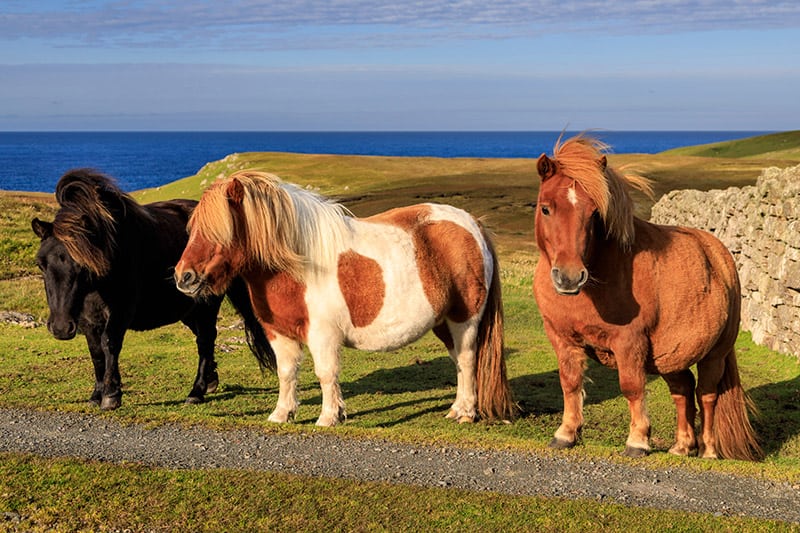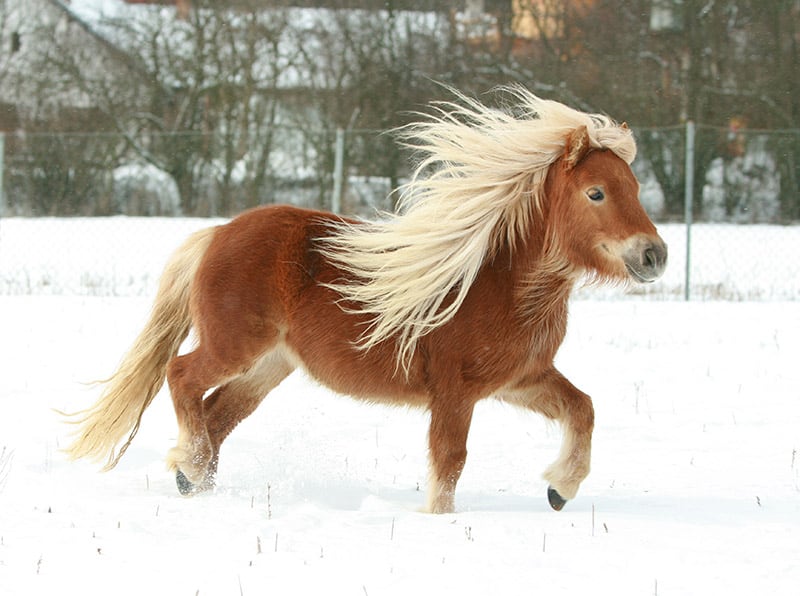Shetland Pony is the strongest horse for its size and can pull up to twice its own weight!
These are hardy and strong ponies built to withstand extreme cold and limited nutritional resources. The development of the Shetland Pony is the result of over 2000 years of living on the Shetland Islands, off the northern coast of Scotland. Here the environment is extremely cold and windy in the winter, and the terrain is very rugged. Their diet is made up of rough heather and grasses able to grow in the thin acid soil, and some seaweed washing up on the shore. Shetland Ponies are an extremely tough and durable breed, with a thick double coat in the winter, and a thick mane and tail to provide extra warmth.
Shetland Ponies are the strongest horse for their size. They can pull up to twice their weight, while draft horses can generally only pull up to half their weight. Some Shetlands can carry up to 130 pounds on their backs, but it is important to be cautious with putting too much weight on their backs because it can lead to back pain and other lameness issues. Many Shetland Ponies are long-lived, and it is not unusual for a Shetland pony to live more than 30 years.
Scientific Classification
| Kingdom: | Animalia |
| Phylum: | Chordata |
| Class: | Mammalia |
| Order: | Perissodactyla |
| Family: | Equidae |
| Genus: | Equus |
| Species: | caballus |
The Shetland Pony is one of the world’s most popular ponies. It can be a great first riding pony for small children due to its small size and gentle personality. They are wonderful children’s mounts for pleasure riding and at riding schools. These ponies are great for harness driving and are a favorite entry in parades. Shetlands can be found at fairs for pony rides and at petting zoos. They are also used as guide animals and in therapeutic programs for the mentally or physically challenged. In the United Kingdom they are featured in the Shetland Pony Grand National, galloping around a racetrack with young jockeys.
The American Shetland Pony Club was founded in 1888 to keep pedigrees for all the newly imported ponies. It now recognizes four separate breeds under one club: the Classic American Shetland, the Modern American Shetland, the American Show Pony, and, very recently, the National Show Pony.
Shetland Ponies
Horse Breeds
The Shetland pony is one of the pony breeds. Ponies are generally considered to be 14.2 hands or smaller at maturity, however, this is a general rule with many exceptions. Pony breeds have a slightly different appearance than the light horse breeds. They usually have thicker manes, tails and coats. They are proportionately shorter-legged and rounder through the barrel. They have somewhat shorter and thicker necks and wider, stronger bones.
Ponies are well known for their superior intelligence and with good horse training, more tractable temperaments. Many of the pony breeds evolved where there was inferior nutrition and which resulted in a smaller breed. Ponies generally require less diligence in their care and often tend to be more independent than the other types of horses.
Well-trained ponies can make wonderful mounts for children. Their small sizes make them less intimidating and are more closely matched to a child’s size and strength. They do well in many disciplines including driving, hunters on the flat and over fences, western driving classes, and pleasure riding. The can also show in dressage, equitation, show jumping, and other events; with top ponies even being competitive against full-sized horses.
Horse Backgrounds
The Shetland pony has lived in the Shetland Islands off the northern coast of Scotland for over 2,000 years. The weather is extremely cold and windy in the winter, and the terrain on these islands is rugged. The thin, acidic soil only supports rough heather and grasses, which along with the seaweed that washes up on shore makes up the staple diet for native Shetlands. This tough environment has made the Shetland extremely hardy. It has a thick double coat in the winter and a thick mane and tail to provide extra warmth.
The origin of the Shetland is unknown, but the most likely theory is that the ponies originated in Scandinavia and crossed the ice fields that once connected Scandinavia to Britain. The ponies were domesticated by the people living on the islands. The native Shetlands were later crossed with lighter ponies that were brought by Norse settlers, as is evidenced by stone carvings of these ponies. In these drawings, the size of the ponies compared to the size of the humans would make the ponies about the size of a Shetland (40 inches in height). The Shetland was probably also influenced by the Celtic ponies that were brought by Celtic tribes between 2000 and 1000 BC.
In more recent times, the Shetland was used by farmers and workers living in the Shetland Islands to work their land, carry loads, and as a means of transport. The ponies carried peat and coal into towns for use as fuel, since there are no wooded trees in the Shetland islands. During the Industrial Revolution in the mid-1800s, thousands of Shetlands were exported to Britain and some to the United States to work as pit ponies in coal mines. A heavier Shetland variety was developed for this purpose, and many of these ponies spent their whole (often short) lives underground in the mines.
In 1890, the first stud book for Shetlands was created in the United Kingdom, called the Shetland Pony Stud Book Society, to encourage the breeding of high-quality animals and to maintain the type (classic look) of the Shetland. Then in 1957, the Shetland Islands Premium Stallion Scheme was developed to subsidize top-quality stallions.
Today, the Shetland had been exported all over the world and it has large populations in Great Britain, Canada, mainland Europe, and the United States. Each country has its own Shetland breed registry and shows. At Shetland shows, the ponies are shown in leadline and riding classes for small children, and in halter and harness driving classes for children and adults.
In 1885, the first Shetlands with written records were imported to the United States by Eli Elliot. These ponies formed the foundation stock for American Shetlands, and were crossed with Hackney Ponies, Welsh Ponies, and Harness Show Ponies. The American Shetland Pony Club was founded in 1888 to keep pedigrees for all the newly imported ponies. It now recognizes four separate breeds under one club, they are:
- Classic American Shetland – The Classic American Shetland is the closest to the original Shetland, although slightly larger and lighter, and must be under 46 inches.
- Modern American Shetland – The Modern American Shetland has been further refined by performance breeds and has high-stepping action. It must be under 46 inches.
- American Show Pony – The American Show Pony has also been further refined by performance breeds and has high-stepping action. It can be up to 48 inches and have either Shetland or Hackney breeding.
- National Show Pony – The newly recognized National Show Pony must have one Shetland parent and can be up to 58 inches. It is meant to allow children to enjoy riding a pony with Shetland characteristics for longer.
The Shetland has also influenced other pony breeds. It is the basis for the Falabella in Argentina, and it was crossed with the Arabian and Appaloosa to create the Pony of the Americas in the United States.

Description
The original breed has a small head, sometimes with a slightly dished face, and widely set eyes and small ears. They have short, thick necks and a compact body, with a short, broad back and a deep girth. The legs are short, and the cannon bones are shorter than normal in relation to their size. They characteristically have a short, bouncy stride.
Shetlands found in the UK tend to conform more closely to the original type, while the Shetlands in the United States are slightly larger and more refined. The Modern American Shetlands and American Show Ponies are considerably lighter, with a thinner neck, leaner body, and longer legs. They are more agile and athletic, with longer strides and high-stepping action.
The height of the Shetland Pony is traditionally counted in inches, not in hands. Shetlands are generally between 38- 40 inches in height, but are not to exceed 42 inches (for most American Shetlands the limit is 46 inches). Shetlands can come in any color except Appaloosa coloring, but black is the original foundation color.
Horse Care and Feeding
Shetland ponies, like many hardy small horse and pony breeds, can easily develop laminitis if on a diet high in non-structural carbohydrates. Therefore owners must pay careful attention to nutrition, being careful to regulate feed quantity and type.
Horse Training and Activities
At Shetland pony shows, classes range from lead line for small children, to competitive driving and halter classes for older children and adults. At American Shetland pony shows in the United States, there are separate classes for each of the four recognized Shetland breeds, and actually two for the Modern American Shetland: under 43 inches and 43 to 46 inches.
The more athletic American Shetland breeds are also successful hunter/jumper and gymkhana mounts for children.
Shetlands have also been very successful at therapeutic programs for the mentally or physically challenged. They are also used as guide animals in a similar role to guide dogs.

Common Health Problems
The Shetland Pony can be very long lived, with some living for over 30 years. However, the small size of the Shetland predisposes some individuals to a greater probability of heart problems than in larger animals, and on occasion, leads to early death.
Availability
Shetland Ponies are very popular in Europe, and especially in the United Kingdom. There are many breeders for American Shetlands throughout the United States and even a few in Canada. They can easily be found through a breeder or through classified ads. A standard pony can be very reasonably priced, but well-bred show ponies can get expensive.
Featured Image Credit: JACLOU-DL, Pixabay
